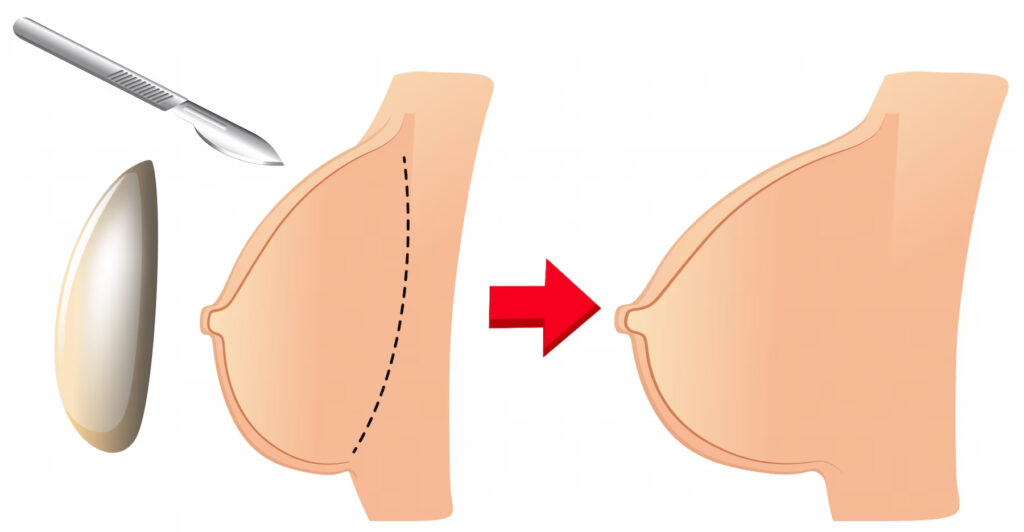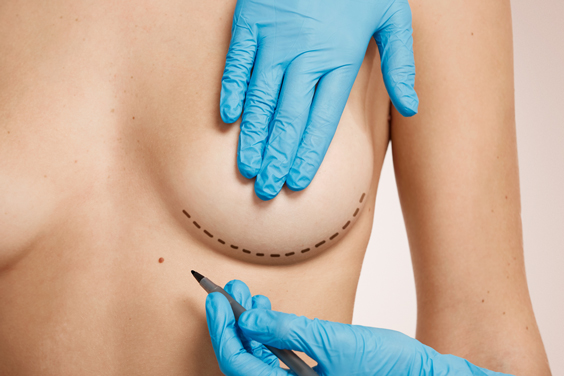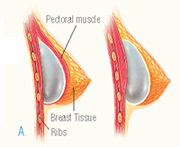Breast Augmentation in Memphis
Breast augmentation surgery involves using implants to increase the size of your breasts or restore breast volume that has been lost after weight reduction or pregnancy. Breast augmentation can:
- Increase fullness and projection of your breasts.
- Improve the balance of your figure.
- Enhance your self-image and self-confidence.

Breast augmentation is a very personal procedure and you should do it for yourself, not for someone else. Breast augmentation is a good option if:
- You are physically healthy
- You have realistic expectations
- Your breasts are fully developed
- You are bothered by the feeling that your breasts are too small
- You are dissatisfied with your breasts losing shape and volume after pregnancy, weight loss, or with aging
- You are unhappy with the upper part of your breast appearing “empty”
- Your breasts are asymmetrical
- One or both breasts failed to develop normally or have an elongated shape
What it won’t do
Breast augmentation does not correct severely drooping breasts. If you want your breasts to look fuller and to be lifted due to sagging, a breast lift may be required in conjunction with breast augmentation.
Breast lifting can often be done at the same time as your augmentation or may require a separate operation. Your plastic surgeon will assist you in making this decision.
Consultation and Preparing for Surgery
- Why you want the surgery, your expectations, and the desired outcome
- Medical conditions, drug allergies, and previous medical treatments
- Current medications, vitamins, herbal supplements, alcohol, tobacco, and drug use
- Family history of breast cancer and results of any mammograms or previous biopsies
Your plastic surgeon will also:
- Evaluate your general health status and any pre-existing health conditions or risk factors
- Examine and measure your breasts, including detailed measurements of their size and shape, skin quality, and placement of your nipples and areolas
- Take photographs
- Discuss your options and recommend a course of treatment
- Discuss likely outcomes of breast augmentation and any risks or potential complications
Prior to surgery, you may be asked to:
- Get a blood test
- Take certain medications or adjust your current medications
- Stop smoking
- Avoid taking aspirin and certain anti-inflammatory drugs as they can increase bleeding
Breast augmentation surgery may be performed in an accredited outpatient or ambulatory surgical center or a hospital.
Be sure to ask your plastic surgeon questions. It’s very important to understand all aspects of your breast augmentation surgery. It’s natural to feel some anxiety, whether it’s excitement for your anticipated new look or a bit of preoperative stress. Don’t be shy about discussing these feelings with your plastic surgeon.
Augmentation Options

The Procedure



Risks and Safety
The decision to have breast augmentation surgery is extremely personal and you’ll have to decide if the benefits will achieve your goals and if the risks and potential complications are acceptable. Your plastic surgeon and/or staff will explain in detail the risks associated with surgery. You will be asked to sign consent forms to ensure that you fully understand the procedure and any risks and potential complications.
The risks include:
- Anesthesia risks
- Bleeding
- Infection
- Changes in nipple or breast sensation
- Poor scarring of skin
- Wrong or faulty position of the implant
- Implant leakage or rupture
- The formation of tight scar tissue around the implant (capsular contracture)
- Fluid accumulation (seroma)
- Wrinkling of the skin over the implant
- Pain, which may persist
- Possibility of revisional surgery
- The development of a type of cancer of the immune system called Breast Implant- Associated Anaplastic Large Cell Lymphoma (BIA-ALCL)
- Breast implants may be associated with systemic symptoms commonly referred to as breast implant illness (BII) which can include fatigue, “brain fog,” muscle or joint pain and rash.
These risks and others will be fully discussed prior to your consent. It is important that you address all your questions directly with your plastic surgeon.
Other important considerations:
- Breast implants are not guaranteed to last a lifetime and future surgery may be required to replace one or both implants
- Pregnancy, weight loss and menopause may influence the appearance of augmented breasts over the course of your lifetime
- Breast augmentation requires regular examinations of your breasts’ health and to evaluate the condition of your implants
Recovery After Surgery
After surgery you will be taken into a recovery area to be closely monitored. Your breasts will be wrapped in gauze dressings and an elastic bandage or support bra will minimize swelling and support the breasts as they heal. You may be permitted to go home after a few hours.
Before leaving, you will be given specific instructions that may include how to care for your breasts following surgery, medications to apply or take orally to aid healing and reduce the risk of infection, and when to follow-up with your plastic surgeon. You may be instructed to wear a support bra around the clock for the first week or two. It will be important to cleanse the incision sites and apply ointment as directed. Be sure to follow all instructions carefully.
After a post-surgical recovery period of 24 to 48 hours and an additional reduced-activity period of a few days, you will likely experience soreness and swelling for a few weeks. Exercise and normal activity can resume at the direction of your plastic surgeon.
Results
The results of breast augmentation are immediately visible. Over time, post-surgical swelling will subside and incision lines will fade. Satisfaction with your new image should continue to grow as you fully recover from surgery. In order to achieve optimal results, it is important that you follow your surgeon’s post-operative instructions and return for follow-up visits.
It’s important to know that breast implants are not designed to last a lifetime. Your implants may need to be replaced. You should plan for an annual examination by your plastic surgeon to evaluate your breast health and implant integrity.
Over time, your breasts can change due to aging, weight fluctuations, hormonal factors and gravity. If, after a period of years, you become dissatisfied with the appearance of your breasts, you may choose to undergo a breast lift or implant exchange to restore a more youthful contour.
Robert Wallace MD
“Dr. Robert D. Wallace has been recognized for many years as one of the best plastic surgeons in the United States and has an international reputation for his work in craniofacial, cleft, and cosmetic surgery. He has been on Castle Connelly’s Top Doc list and Best Doctors award for many consecutive years. In addition, he was selected by Newsweek magazine in 2021 and 2022 as one of the top 100 plastic surgeons in the USA on their list for facelift and rhinoplasty surgery. In 2022 he was honored by Memphis Business Journal with the Healthcare Hero award in the physician category for his work in pediatric and craniofacial surgery. He has published multiple medical articles and book chapters in plastic surgery literature.”

Get In Touch
If you have any questions or want to schedule an appointment, contact us and our team will be glad to support you